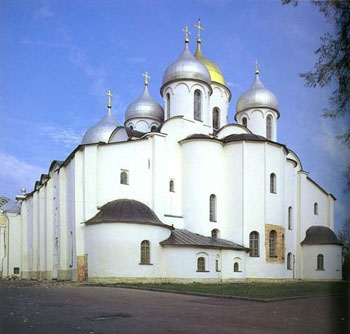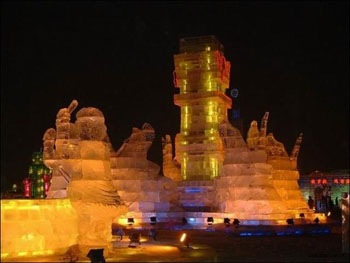search for a Trip
The introduction of Harbin
Harbin (Ha'erbin), capital of Heilongjiang, China's northernmost province, is a place of many contradictions. Travelers are faced with frequently cold and inhospitable climates, but comforted by a warm and friendly population, increasing huge and stark skyscrapers, but also winding streets of quaint, colonial architecture, and impressive Siberian Tiger conservation policies that are somewhat offset by hunting grounds where a variety of animals are killed for pleasure. These contradictory scenes continue back in time, so that the history of Harbin is one of turbulence and economic prosperity.
Main attractions in Harbin
Church of St.Sophia
 The Russian influence in Harbin, including a continuing strong Russian population here, is no better felt than a wander around the streets that make up the Daoli district, in the northwest of the city. Among the many Orthodox churches and Russian style facades in this region, the St. Sophia Orthodox Church (Shengsuo feiya dajiaotang) is the most impressive, and imposing, structure. In 1903, with the completion of the Sino-Russia railway, connecting Vladivostok to northeast China, the Russian No.4 Army Division arrived in this region. After Russia's shameful failure against the Japanese in the Russo-Japanese War (1904-1905), a plan to reconsolidate the confidence of the army by building a imposing spiritual symbol was proposed. Thus the magnificent St. Sofia Church was born, completed in 1907. Large scale expansion and renovation then started in 1923, and after a nine years' intensive job, the biggest Orthodox church in the far east was finally completed and stood much as it does today. The 53m tall church is a perfect example of Byzantine architecture: the main structure of the church is laid out as a Latin Cross with the main hall topped with a huge green tipped roof. Under the bright sun, the church, together with the square around it, reminds the Chinese, bizarrely, of the Red Square in Moscow. Although there are still several hundred Orthodox believers in Harbin, the religious activities are usually conducted in other smaller churches. St. Sofia Church is nowadays used as the Municipal Architecture and Art Museum with exhibitions of the architectural history of the city, a photographic survey with captions all in Chinese.
The Russian influence in Harbin, including a continuing strong Russian population here, is no better felt than a wander around the streets that make up the Daoli district, in the northwest of the city. Among the many Orthodox churches and Russian style facades in this region, the St. Sophia Orthodox Church (Shengsuo feiya dajiaotang) is the most impressive, and imposing, structure. In 1903, with the completion of the Sino-Russia railway, connecting Vladivostok to northeast China, the Russian No.4 Army Division arrived in this region. After Russia's shameful failure against the Japanese in the Russo-Japanese War (1904-1905), a plan to reconsolidate the confidence of the army by building a imposing spiritual symbol was proposed. Thus the magnificent St. Sofia Church was born, completed in 1907. Large scale expansion and renovation then started in 1923, and after a nine years' intensive job, the biggest Orthodox church in the far east was finally completed and stood much as it does today. The 53m tall church is a perfect example of Byzantine architecture: the main structure of the church is laid out as a Latin Cross with the main hall topped with a huge green tipped roof. Under the bright sun, the church, together with the square around it, reminds the Chinese, bizarrely, of the Red Square in Moscow. Although there are still several hundred Orthodox believers in Harbin, the religious activities are usually conducted in other smaller churches. St. Sofia Church is nowadays used as the Municipal Architecture and Art Museum with exhibitions of the architectural history of the city, a photographic survey with captions all in Chinese.

Ice Lantern Festival
Also known as "Ice City", Harbin is most famous in China for its winter scenery and bitterly cold temperatures that accompany the freezing environment. The Harbinese however, really know how to exploit and make the most out of their situation and have a long tradition of using ice and snow in an amazingly creative and varied number of ways. Frozen lakes are used as natural skating grounds, ground snow is used instead of a refrigerator and even the frozen Songhua lake was once used as a highway.
Ice sculptures first came into being as a traditional Chinese art form during the early Qing dynasty some 350 years ago. Over time, various types and shapes of sculpture have been designed and developed, all enhancing the status of this somewhat unusual art form so that today the annual Ice Festival is televised nationwide, attracting millions of viewers. Today, the annual Ice Lantern Festival is held in Harbin from the 5th of January to the end of February. During this time, thousands of ice lanterns,carvings and buildings are exhibited and paraded on huge floats through the city. This is a great experience and even the most cynical visitor cannot fail to be impressed by the sheer size and scale of work that goes into producing many of the sculptures.
Yabuli Ski Resort:
The Yabuli Ski Resort (Yabuli huaxue chang) is located in Shangzhi city, a county city about 150km east of Harbin. As a subrange of the Changbai Mountain Range (Changbai shan), the resort is one of the best natural skiing resorts in China. The area enjoys an average annual temperature of minus 1 degrees C., the freezing period of the region being often as long as six months, from October to April. The snow depth averages 39cm and gets up to 60cm in high altitude regions.
The Resort is currently not only the biggest but also the best established and facilitated skiing resort in China. The 3800m long main skiing trail here is located at an altitude of 1300m. Cable car lifts are available. The whole resort is surrounded by imposing mountain ranges lavishly covered with pine forests. Besides the spectacular view, wild animals are also frequent sights on the resort. In February 1996, the Yabuli Ski Resort hosted the third Asian Winter Sports Games, the biggest winter sports event ever held in China.
Yuquan Hunting Ground
Yuquan Hunting Ground (Yuquan shouliechang) is currently the biggest close hunting ground in China. It is located to the west of Harbin, on the sub range of the Changbai Mountain (Changbaishan). With a total area of 3000 hectares, the hunting ground enjoys a forest coverage of 80 percent and has seventeen peaks all over 3000m. Clean streams and rare plants can be found throughout the region, which is home to various specious of wildlife including goats, deer and rabbits. Please remember to leave those Siberian Tigers alone.
Besides hunting, the resort also provides lodging in its uniquely designed traditional hunter's wooden domes, skiing, barbecue and horse riding. This is perhaps not the nicest of activities that is to be had in China, although hunting is not the only thing that can be done here. It is also only to be considered for those with a bit of wealth on their hands, there are a few heavy expenses to be considered beyond travel, accommodation and food, most importantly a variable per animal fee.
Climate in Harbin
|
Month |
Jan |
Feb |
Mar |
Apr |
May |
Jun |
Jul |
Aug |
Sep |
Oct |
Nov |
Dec |
|
Temperature (Celsius) |
-13.1 |
-8.6 |
1.5 |
12.7 |
21.1 |
25.9 |
28.0 |
20.4 |
20.7 |
11.8 |
-0.1 |
-9.9 |
China Attractions Guide
- Anhui Attractions
- Beijing Attractions
- Chongqing Attractions
- Fujian Attractions
- Gansu Attractions
- Guangdong Attractions
- Guangxi Attractions
- Guizhou Attractions
- Hainan Attractions
- Henan Attractions
- Hongkong Attractions
- Hubei Attractions
- Hunan Attractions
- Inner Mongolia Attractions
- Jiangsu Attractions
- Jiangxi Attractions
- Manchuria Attractions
- Ningxia Attractions
- Qinghai Attractions
- Shaanxi Attractions


